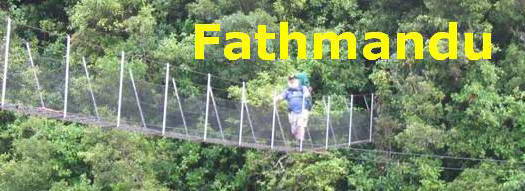
Many thanks for permission to use graphics from their software and toposheets |
 |
|
Dave's Modified Short Loop Track - 02
From here on in we can keep our ears open for tui, grey warbler, shining cuckoo and native pigeons, and of course, around here, the more or less inevitable magpies. The immediate area is mainly regenerating bush under a canopy of Kanuka. Common alongside the track are koromiko, various small and large leaved coprosmas, kawakawa, ake ake, kaihua, clematis, korokio, pate and five finger, rangiora, hangehange, mapau, and, near the reserve gate, a largish karo. Click here for a more detailed observation and discussion of the native plants, shrubs and trees along the way. Too often when I'm tramping, I'm looking at the ground in front of me and I miss the gracefulness of tree branches against the sky.
A few hundred metres up the track is the Old Lookout. If you know the history of this spot, I'd love to hear from you. (Use the link on the menu bar.) What we have left is a couple of steepish sided mounds about a metre or so high and roughly square to rectangular.
There's some old concrete steps, and a couple of concrete items that might have been the base for a fireplace or an oven. It makes a fine picnic table.
The area immediately around is an old garden. There's London Pride which you can see just above, and periwinkle, an odd potato and a largish patch of grape vines sprawling across the ground.
Off to the side are the rusting remains of an old full size tin bath. Just across the path is a smaller mound, square, with a block like this at each corner.
It might have been the base of a trig station - this is the highest spot for a kilometre or two, but I'm picking this was some kind of firewatch tower, with a resident firewatcher - possibly a university student catching up on his reading over the summer, possibly, given the garden, some longer term resident. There's an older mahoe on the mound also, its leaves smaller and more leathery than the vigorous new growth on the young ones.
The scientific name of mahoe means "flowering on the branches" Of possibly more interest here are several specimens of rohutu, (Lophomyrtus obcordata) a tree with small round leaves very similar to a coprosma or muehlenbeckia, but with a flower a bit like a white pohutukawa, (same family) and a very distinctive papery reddish bark.
For a tree that is simply covered in bloom, there are surprisingly few berries here when I return some weeks later.
From here, the path heads downhill to the first of several lookouts complete with bench to sit on. At first the path is open, through somewhat scruffy regrowth,
and as we descend it becomes darker as tall rewarewa, kohekohe, kowhai and big mahoe take over as the dominant species There's also a splendid puriri, about a metre across and riddled with moth holes, right beside the lookout
Also to be seen along this path: the brilliant purple berries of Dianella nigra.
|
|